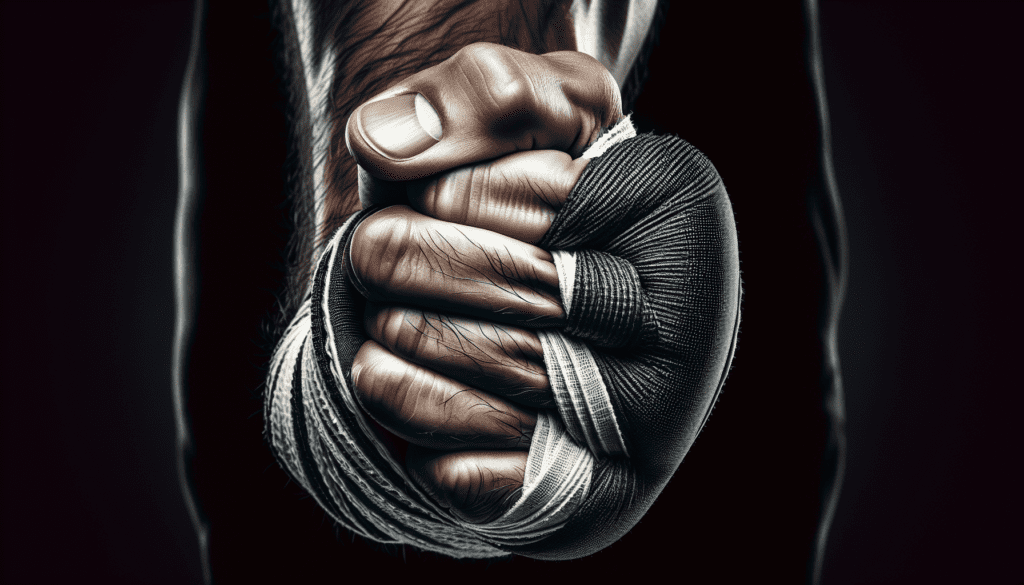Are you an aspiring mixed martial artist looking to avoid those pesky muscle strains and sprains that can sideline you for weeks? Look no further! In this article, you will discover valuable tips and techniques on how to prevent muscle strains and sprains in MMA. From proper warm-up exercises to incorporating stretching routines into your training regimen, we’ve got you covered. Say goodbye to those nagging injuries and hello to a stronger, healthier you in the Octagon.
Warm up properly
Dynamic stretching
Before starting any intense physical activity, it is crucial to warm up properly to prepare your body for the upcoming demands. One effective way to warm up is through dynamic stretching. Dynamic stretching involves movement-based stretches that gently mobilize your muscles and joints. By incorporating dynamic stretching into your warm-up routine, you can improve your range of motion, decrease the risk of muscle strains, and enhance your overall athletic performance.
Joint mobility exercises
Alongside dynamic stretching, incorporating joint mobility exercises into your warm-up routine can significantly benefit your body in MMA training. Joint mobility exercises focus on moving your joints through their full range of motion. These exercises improve joint lubrication, increase blood flow to the surrounding tissues, and reduce the risk of injury. By engaging in joint mobility exercises before your training sessions, you can improve your overall joint health and allow for better movement during your MMA practice.
Light cardio
In addition to dynamic stretching and joint mobility exercises, including a light cardio activity in your warm-up routine can be highly beneficial. This could involve activities such as jogging, cycling, or jumping rope. Light cardio helps to elevate your heart rate, increase blood flow to your muscles, and warm up your entire body. By incorporating light cardio into your warm-up, you can gradually increase your body temperature and improve your overall performance while reducing the risk of muscle strains and sprains.
Strengthen the muscles
Resistance training
To prevent muscle strains and sprains in MMA, it is essential to have strong muscles. This can be achieved through resistance training, which involves using external resistance such as weights, resistance bands, or bodyweight exercises to build strength. Resistance training targets specific muscle groups, helping them become stronger and more resilient to injuries. By regularly incorporating resistance training exercises into your training routine, you can improve overall muscle strength and reduce the risk of strain or sprain.
Core exercises
In MMA, having a strong core is crucial for stability, power, and injury prevention. Core exercises specifically target the muscles in your abdomen, lower back, and hips. These exercises include planks, Russian twists, and bicycle crunches. By incorporating core exercises into your training routine, you can develop a strong core, which will provide better stability for your entire body during MMA movements and reduce the risk of muscle strains or sprains.
Balance exercises
Balance is an essential skill in MMA that helps with stability, coordination, and injury prevention. Incorporating balance exercises into your training routine can significantly enhance your overall performance and reduce the risk of muscle strains and sprains. Balance exercises can include single-leg exercises, stability ball exercises, or yoga poses that challenge your stability and improve your body awareness. By improving your balance through targeted exercises, you can maintain better control over your movements and avoid potential injuries.

Improve flexibility
Static stretching
Another important aspect of injury prevention in MMA is maintaining and improving flexibility. Static stretching is a popular method used for this purpose, and it involves holding a stretch for a specific period. Static stretching helps increase muscle and tendon flexibility, which can reduce muscle strains or sprains during training or competition. By incorporating static stretching into your cool-down routine or separate stretching sessions, you can improve joint mobility, decrease muscle tension, and reduce the risk of injuries.
Yoga or Pilates
Yoga and Pilates are two highly effective practices that can help you improve flexibility, body control, and prevent muscle strains and sprains in MMA. These practices focus on controlled movements, deep stretches, and body awareness. In particular, yoga emphasizes flexibility, balance, and breath control, while Pilates centers around core strength and body alignment. By regularly practicing yoga or Pilates, you can increase your overall flexibility, enhance body control, and reduce the likelihood of muscle strains or sprains.
Foam rolling
Foam rolling, also known as self-myofascial release, is another excellent method to improve flexibility and prevent muscle strains and sprains in MMA. Foam rolling involves using a foam roller to apply pressure to different muscles and fascia in your body. This technique helps release muscle tightness, increase blood flow, and improve tissue mobility. By incorporating foam rolling into your warm-up or cool-down routine, you can enhance your muscle flexibility and reduce the risk of strains or sprains.
Use proper technique
Enlist a qualified coach
To prevent muscle strains and sprains in MMA, it is crucial to learn and use proper technique. Enlisting the guidance of a qualified coach is highly recommended as they can teach you the correct form, movements, and techniques specific to MMA. A coach can also provide valuable feedback and help you avoid common mistakes that may lead to injuries. By ensuring you have a knowledgeable coach guiding your training, you can effectively learn and practice proper technique to minimize the risk of muscle strains or sprains.
Focus on correct form
When participating in MMA training or competitions, it is essential to prioritize correct form and technique. Focusing on correct form ensures that you are performing movements in a biomechanically efficient and safe manner. It helps distribute the load evenly across your muscles and joints, reducing the risk of strain or sprain. By continuously practicing and refining your form, you can improve your performance, prevent injuries, and maintain a strong, balanced body.
Listen to your body
One of the most important aspects of preventing muscle strains and sprains in MMA is listening to your body. Your body provides valuable signals and feedback, and it is essential to pay attention to any discomfort or pain. If you feel a muscle is becoming strained or a joint is feeling unstable, it is crucial to address the issue promptly. Ignoring these warning signs can lead to more severe injuries. By listening to your body and addressing any concerns, you can take the necessary steps to prevent muscle strains or sprains before they occur.

Avoid overtraining
Schedule rest days
Overtraining is a common cause of muscle strains and sprains in MMA. It is essential to prioritize adequate rest and recovery to avoid overworking your body. Scheduling rest days within your training routine allows your muscles and joints to recover, repair, and adapt to the demands of MMA training. Rest days also help prevent mental fatigue and burnout, allowing you to train at optimal performance levels. By listening to your body’s need for rest and incorporating regular rest days, you can avoid overtraining and reduce the risk of muscle strains or sprains.
Gradually increase intensity
When it comes to training in MMA, it can be tempting to push your limits and increase intensity quickly. However, this approach significantly increases the risk of muscle strains and sprains. To prevent injuries, it is crucial to gradually increase the intensity of your training over time. This gradual progression allows your muscles, tendons, and joints to adapt and become stronger. By progressively challenging your body, you can minimize the risk of strains or sprains and improve your overall performance.
Monitor training volume
Monitoring your training volume is important in preventing overtraining and muscle strains or sprains in MMA. Training volume refers to the total amount of training you do, which includes factors such as duration, frequency, and intensity. It is essential to strike a balance between training hard and allowing enough time for recovery. Monitoring your training volume helps prevent excessive strain on your body and ensures you are not overwhelming your muscles and joints. By keeping track of your training volume and making adjustments when necessary, you can maintain a healthy training regimen and reduce the risk of injuries.
Maintain proper nutrition
Eat a balanced diet
Maintaining proper nutrition is vital for preventing muscle strains and sprains in MMA. Consuming a well-balanced diet provides your body with the necessary nutrients, vitamins, and minerals to support optimal performance and recovery. A balanced diet should include a variety of fruits, vegetables, lean proteins, whole grains, and healthy fats. These foods provide energy, promote muscle growth and repair, and support overall health. By fueling your body with proper nutrition, you can enhance your muscle strength, reduce the risk of strains or sprains, and improve your overall performance in MMA.
Stay hydrated
Staying hydrated is an often overlooked aspect of injury prevention in MMA. Dehydration can lead to muscle cramps, fatigue, and impaired physical and mental performance. It is essential to stay hydrated before, during, and after training sessions. Drinking sufficient water helps lubricate your joints, deliver nutrients to your muscles, and remove waste products efficiently. By ensuring you are adequately hydrated at all times, you can optimize your body’s performance, reduce the risk of muscle strains or sprains, and promote overall health.
Get sufficient nutrients
In addition to maintaining a balanced diet and staying hydrated, it is important to ensure you are getting sufficient nutrients to support your muscles and prevent strains and sprains. This includes consuming an adequate amount of protein to support muscle repair and growth. Good sources of protein include lean meats, fish, poultry, dairy products, and plant-based options such as legumes and tofu. Additionally, consuming foods rich in vitamins and minerals, such as fruits and vegetables, can help support overall muscle and joint health. By prioritizing a nutrient-rich diet, you can provide your body with the necessary tools to prevent muscle strains or sprains.
Wear appropriate safety gear
Padded gloves
When participating in MMA training or competitions, wearing appropriate safety gear is crucial to prevent muscle strains and sprains. One essential gear is padded gloves. Padded gloves help protect your hands, wrists, and knuckles during striking movements. They absorb impact and reduce the risk of injuring your hands or spraining your wrists. Investing in high-quality padded gloves that properly fit your hands is essential for optimal safety and injury prevention in MMA.
Mouthguard
Protecting your teeth, jaw, and head is of utmost importance in MMA. Wearing a mouthguard provides a layer of protection for your teeth and helps absorb impact from strikes or falls. A mouthguard also helps reduce the risk of concussions or jaw injuries. It is crucial to choose a well-fitting mouthguard that provides sufficient coverage and protection. By wearing a mouthguard during training and competitions, you can significantly reduce the risk of dental or head injuries and prevent potential muscle strains or sprains.
Protective headgear
For additional protection, especially during sparring or other contact-based drills, wearing protective headgear is highly recommended. Headgear provides cushioning and protects your head, ears, and face from impact and potential injuries. It helps minimize the risk of cuts, bruises, concussions, or strains in the head and neck area. Similar to other safety gear, it is important to choose headgear that fits properly and provides adequate protection for your specific needs. Wearing protective headgear can significantly reduce the risk of muscle strains or sprains and promote overall safety in MMA.
Pay attention to recovery
Stretch after training
After intense MMA training sessions, it is essential to prioritize recovery to prevent muscle strains and sprains. Stretching after training can help improve flexibility, reduce muscle soreness, and enhance recovery. By performing static stretches or using techniques such as active isolated stretching, you can promote muscle relaxation and prevent tension buildup. Stretching also helps maintain or improve your joint mobility, reducing the risk of strains or sprains during future training sessions.
Use ice or heat therapy
Incorporating ice or heat therapy into your recovery routine can be highly beneficial for preventing muscle strains and sprains in MMA. After intense training, applying ice to sore or inflamed areas helps reduce swelling and alleviate pain. Ice therapy also numbs the area, providing pain relief. Heat therapy, such as using a heating pad or warm compress, can help relax muscles, increase blood flow, and promote healing. Alternate between ice and heat therapy based on your specific needs to optimize recovery and minimize the risk of muscle strains or sprains.
Get enough sleep
Proper sleep is crucial for optimal recovery and injury prevention in MMA. During sleep, your body repairs and rebuilds damaged muscle tissues. Insufficient sleep can lead to decreased muscle recovery and increased risk of strains or sprains. Aim to get a good night’s sleep of 7-9 hours to support your body’s recovery process. Establishing consistent sleep patterns and creating a sleep-friendly environment can help improve the quality of your sleep. By prioritizing sufficient sleep, you can enhance recovery, reduce the risk of muscle strains or sprains, and maintain overall physical and mental well-being.
Listen to your body
Recognize warning signs
Listening to your body’s warning signs is crucial in preventing muscle strains and sprains in MMA. It is important to pay attention to any abnormal sensations or discomfort during training or competitions. These warning signs can include muscle tightness, localized pain, joint instability, or decreased range of motion. By recognizing and acknowledging these warning signs, you can take appropriate measures to prevent further injury and seek necessary treatment or rest.
Don’t ignore pain or discomfort
Pain or discomfort should never be ignored in MMA training. Ignoring pain can lead to more significant injuries and prolonged recovery time. If you experience any pain or discomfort during training, it is essential to stop and assess the situation. Continuing to push through pain can worsen the injury and increase the risk of muscle strains or sprains. By prioritizing your safety and well-being, you give yourself the opportunity to heal and prevent further harm.
Seek medical attention if necessary
If you experience persistent or severe pain, or if you suspect a muscle strain or sprain, it is crucial to seek medical attention. A healthcare professional can provide an accurate diagnosis and recommend appropriate treatment options. They may suggest rest, physical therapy, or other interventions depending on the severity of the injury. By promptly seeking medical attention, you can ensure proper care, prevent further damage, and facilitate a faster recovery.
Incorporate cross-training
Include different types of exercises
Cross-training involves incorporating a variety of exercises and training modalities into your routine. This approach helps prevent overuse injuries and muscle strains or sprains by allowing your body to adapt and recover. Including different types of exercises, such as swimming, cycling, or strength training, targets different muscle groups and reduces repetitive strain. By incorporating cross-training into your MMA training program, you can improve overall fitness, reduce the risk of overuse injuries, and enhance your performance.
Give muscles a break from repetitive movements
Repetitive movements can strain your muscles and increase the risk of strains or sprains. To prevent these injuries, it is essential to give your muscles a break from repetitive movements. For example, if you primarily focus on striking in your MMA training, consider incorporating grappling or conditioning exercises to provide variety and give your striking muscles a break. By giving your muscles rest from repetitive movements, you can reduce the risk of strain or sprain and promote overall muscle balance and longevity.
Improve overall fitness and reduce injury risk
Incorporating cross-training into your MMA training program is a valuable strategy to improve overall fitness and reduce the risk of muscle strains and sprains. By engaging in different forms of exercise, you can improve cardiovascular endurance, increase strength in different muscle groups, and enhance flexibility. These benefits contribute to better overall fitness, reducing the strain on specific muscle groups and minimizing the risk of injury. By adopting a well-rounded training regimen, you can improve your performance in MMA and safeguard against muscle strains or sprains.
In conclusion, preventing muscle strains and sprains in MMA requires a comprehensive approach. By warming up properly, strengthening your muscles, improving flexibility, using proper technique, avoiding overtraining, maintaining proper nutrition, wearing appropriate safety gear, paying attention to recovery, listening to your body, and incorporating cross-training, you can reduce the risk of these injuries and enhance your performance in MMA. Remember to always prioritize safety, listen to your body, and seek professional advice when necessary. With a proactive mindset and the right strategies, you can enjoy a safe and successful MMA journey.

